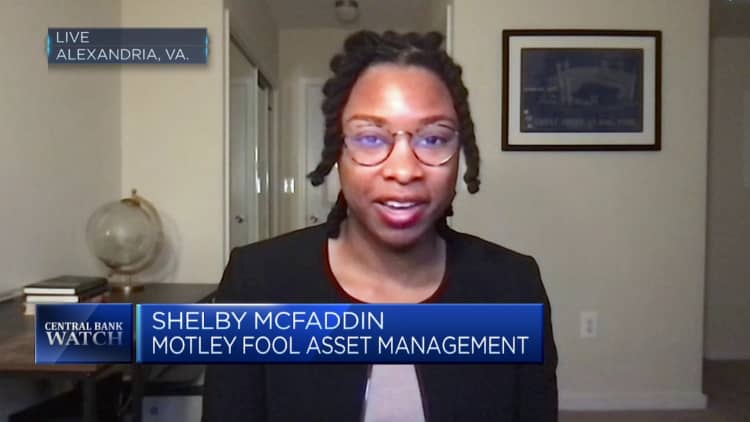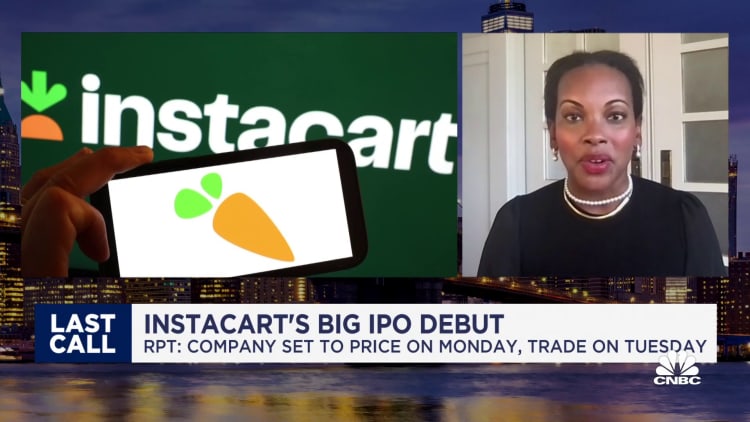[ad_1]
Shopper using Instacart
Source: Instacart
As tech startups test the IPO market again, they are pushing up their valuations.
After last week’s successful market debut of chip company Arm, two of the most eagerly anticipated IPOs of former high-flying startups have upped their initial public offering valuations — online grocery firm Instacart and marketing automation company Klaviyo.
But don’t be fooled. In upping IPO ranges, tech stocks are still coming out humbled by the post-2021 IPO market slump. The slate of recent and planned tech initial public offerings will test the market’s appetite for new stocks, and experts say the overall IPO resurgence could be slow — and not without bumps.
Instacart and Klaviyo are both expected to make their debuts on the public market as soon as this week. Arm’s jump of nearly 25% during its first trading day Thursday marked the end of a quiet two years for tech IPOs. But these companies are coming to market in a much different environment than those that went public during the IPO, SPAC and meme stock frenzies of 2020 and 2021. Since then, companies have been contending with record-high inflation, interest rate hikes, concerns for the banking sector, and volatile markets.
The majority (70%) of 73 IPOs year-to-date were trading below their IPO price at the time of Arm’s deal, but most are smaller cap companies, and about half are based outside the U.S.
“We see this as a major turning point,” Matt Kennedy, senior IPO market strategist for Renaissance Capital, said of the first major tech IPOs of the year. “This has been the slowest IPO market in over a decade and we seem to be finally coming out of that.”
Investors are struggling to assess what companies are worth and are waiting for the IPO market to pick back up, said Ray Wang, principal analyst and founder at Silicon Valley-based Constellation Research.
“It’s a valuation game and what we’re all trying to figure out right now is, what are they really worth?” Wang said. Growth expectations are down, the availability of funding for these types of investments is down, and many investors are still sitting on the sidelines, he added.

Debuting in an uncertain market means companies and investors have had to say goodbye to the soaring valuations they saw when the IPO market was buzzing two years ago. But Instacart raised its valuation target on Friday to up to $10 billion from as much as $9.3 billion after Arm’s successful market debut. That is still a steep decline from the grocery company’s $39 billion valuation in 2021, and a 75% hit to be absorbed by venture capital investors. Klaviyo is targeting a valuation of up to $9 billion on a fully diluted basis, just slightly below its $9.5 billion valuation in 2021.
The rising cost of raising capital as a result of the Federal Reserve’s interest rate hikes has weighed on future cash flows of companies and their overall valuations. The state of the global economy and the standstill in the IPO market since 2021 has also put a damper on valuations, Wang said.
The market product Instacart is selling
The good news: valuations look “a lot more reasonable,” Kennedy said, compared to two years ago when investors were basically willing to pay anything. He said investors are more focused on profitability than they were in 2021 and companies are recognizing that. Broadly, the tech pipeline has spent the last two years attempting to improve profitability in order to come to market while maintaining their growth and trying to pitch a reasonable valuation, he added.
Instacart is a prime example of this approach to a successful IPO, looking more like a value stock today than a high-flying, money losing tech startup.

“They really need to show that they have a strong fundamental base,” Kennedy said.
Instacart and Klaviyo have solid growth similar to what investors saw two years ago, and importantly, now these companies are not hemorrhaging cash, he added.
Instacart and Klaviyo’s lower valuations could be indicative of the outlook for other venture capital-backed companies and tech IPOs going forward — even those that are profitable, said Kyle Stanford, lead VC analyst at PitchBook. “There’s going to be a struggle for a lot of tech companies and VC-backed companies to come to the public markets and get a positive valuation jump from the get-go,” he said.
He doesn’t expect these highly anticipated public debuts to translate into an immediate broader resurgence of tech IPOs. The opportunity for tech debuts will likely be slower over the rest of the year than many people want to see, Kennedy said, though it can slowly gain momentum with a more typical IPO market possible by early 2024.
What to know before investing in IPO stocks
IPOs can have very volatile trading in the first weeks or even months after a listing. That may be especially true for some of the current deals since they’re the first major tech IPOs of the year and have a relatively lower proportion of shares being sold relative to market cap than historical averages, Kennedy said.
“My advice would be don’t feel like you need to chase the crowd,” Kennedy said. “And if you do, at least be aware that that’s what you’re doing and have an exit strategy in mind.”
There tends to be an initial excitement with IPOs during which the price gets bid up before losing momentum. Often it’s better to wait until after the first major pullback, Kennedy said.
While these tech IPOs are growth companies, their recent profitability doesn’t guarantee that they’ll be profitable in the long term. And according to Stanford, if the market doesn’t shift back to putting a premium on growth, they’re going to have a difficult time in the public market.
“These companies are risky, especially in a market where your two-year bond is paying almost 5%,” Stanford said. “It’s still an uncertain market and if inflation were to rise back up or interest rates continue to go back up, these riskier tech stocks are going to take a hit.”
Companies will need to show continued growth, profitability and a decent valuation before we see the IPO market back in full swing, Kennedy said.
[ad_2]

